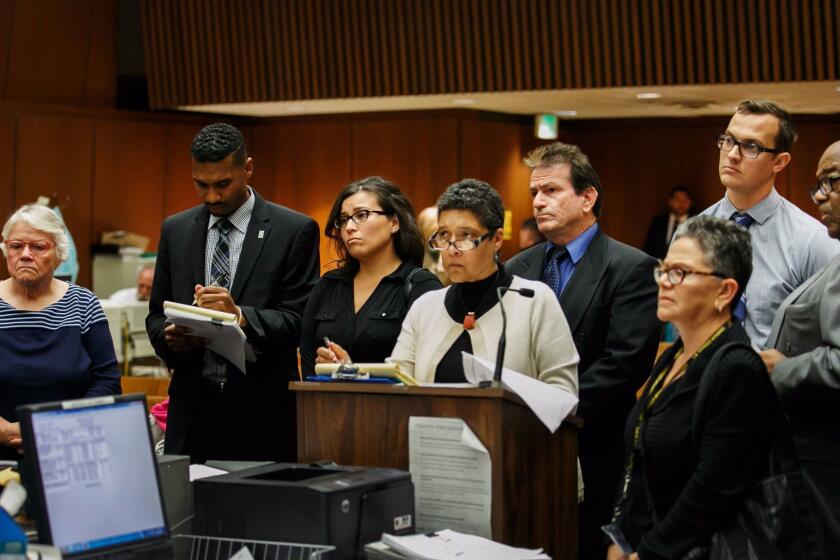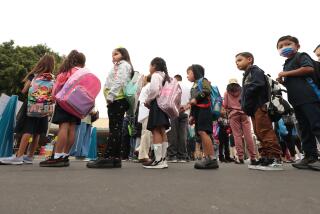Editorial: L.A. Unified’s new challenge: Getting students to show up for online classes
- Share via
This last spring, Los Angeles Unified students weren’t in school. They weren’t physically in schools because those had been closed in the face of the pandemic, of course. But far too many of them weren’t in virtual school, either.
Signs emerged quickly that tens of thousands of students weren’t showing up for their remote lessons. Now a new report by the school district shows how badly the shift online affected the students who tend to need educational help the most: those who were low-income, Black and Latino, homeless, not fluent in English, or with special educational needs.
The numbers, depressing as they are, stemmed from the most difficult of circumstances. Not all students had the equipment they needed right away, despite L.A. Unified’s quick efforts on that front. Families were understandably more worried about their safety and ability to house and feed their children than about lessons. Teachers weren’t well prepared. Who was? During such unprecedented times, when no one knew what kinds of hardships families were facing at home, it made little sense to take regular attendance or stick to the usual grading rubrics. But as a result, student motivation suffered.
In middle school, for example, peak weekly participation was close to 90% for white and Asian students, but only about two-thirds of Black and Latino students were engaged in their lessons at least once a week. Put another way, a third of the Black and Latino students who make up the bulk of L.A. Unified’s middle school enrollment weren’t getting involved in their studies for an entire week at a time, many times over.
The attendance rates were slightly higher among high school students. Elementary schools weren’t included in the report because they used a variety of different online platforms, but Supt. Austin Beutner said that overall, their participation would be no higher and quite possibly worse, because young children relied on their parents for help using computers.
Low-income students were even less likely to participate in their lessons at least once a week, and more than half of those who aren’t fluent in English weren’t showing up weekly.
Prison is seldom the answer to social or governmental failures.
In other words, wave after wave of students fell precipitously back in their education. And not just at L.A. Unified. School districts throughout California and the nation with large numbers of students beset by poverty and other challenges saw similarly low levels of attendance.
Attendance is an issue for L.A. Unified in the best of times. About 15% of its students are chronically absent, meaning they miss at least 10% of school days. But in online courses, large numbers of students were hardly participating at all; they were considered present if they engaged with their studies just once per week, and many weren’t even doing that.
Devoted teachers tried to reach their missing students but often could get no answer, even with phone calls to parents. In full lockdown, no one could go knocking on doors to let parents know that their children weren’t doing their schoolwork regularly.
Given Gov. Gavin Newsom’s announcement Friday that most schools in the state will have to go online-only this fall, dozens of districts will have to confront the ways in which spring learning was an educational disaster. But online instruction can be, and has to be, vastly better this fall, with more ambitious and engaging lessons, offered on a regular basis, and with students showing up to learn.
There’s time to prepare. Time to train teachers and to work out a better memorandum of understanding with their unions that requires a significant amount of live instruction and other personal interactions with students online. This time, the state is mandating that schools take attendance, grade student work and follow a somewhat more normal class schedule.
Something else has changed as well: our level of lockdown. No longer are people barred from leaving their homes except for walks in the neighborhood and trips to hunt for rice and toilet paper. School staff, properly equipped with masks and other personal protection, could spread out in neighborhoods to visit families and find out why students aren’t logging in to their lessons and doing their assignments. These chats should happen outdoors, which is a safer setting for everyone to talk, with masks and physical distancing.
The staff conducting these visits could do more than inform parents about their students’ absenteeism; they could also check whether the family is all right and whether it has special needs that the district or government agencies could help resolve in this time of crisis.
Teachers, of course, will have their hands more than full. But school nurses, whose services were for the most part not used last spring, are ideally equipped to check on how families are faring. Bus drivers, aides and administrative assistants also could do this work; their unions should be working out agreements with the district. Everyone who is still being paid and has something to contribute to the educational effort should be doing so.
More to Read
A cure for the common opinion
Get thought-provoking perspectives with our weekly newsletter.
You may occasionally receive promotional content from the Los Angeles Times.











